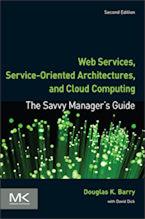Consulting: Research, Analysis, and Customized Working Sessions
Specializing in enterprise architecture with an emphasis in service-oriented architecture, database systems, and object technology, Doug Barry's practice is aimed at accelerating your understanding and use of software technology. An author, columnist, guest lecturer, international speaker, and mentor, his most recent book is Web Services, Service-Oriented Architectures, and Cloud Computing: The Savvy Manager' Guide. More on Doug and his publications.
Research and Analysis Services
Design review
Do you have a design in place? Are you sure it is the most effective design for your needs? This review provides trouble-shooting and critiquing of high-level designs by Doug Barry, who has been conducting design reviews for over 25 years. Prior design reviews have been in the areas of database design (relational and object database management systems) and service-oriented architecture.
Technical due diligence
Doug Barry provides technical due diligence on software products that clears away the "technical noise" to describe the product opportunity clearly to investors. Prior technical due diligence has been in the areas of pharmaceutical trial tracking software, systems integration, and open systems.
Technical market positioning
Are you trying to determine how your product compares technically to similar products in the marketplace? Are you looking for a perspective on how to position your product? Doug Barry has been helping people with technical market positioning for over ten years. Prior technical market position has been in the areas of software development tools and infrastructure tools for a service-oriented architecture.
Patent review
Doug Barry provides technical research related to proposed or existing patents. Prior reviews have been related to various types of database technologies and object technology.
Customized Working Sessions for Your Service-Oriented Architecture
Tired of generic workshops and webinars? These customized sessions are designed to work on your project to provide actionable results.
Envisioning your transition to a service-oriented architecture: A facilitated technical discussion
In Doug Barry's most popular offering, your group will work through a practical hands-on discussion of how to use a service-oriented architecture in your organization. Your group will exchange ideas, concerns, and opportunities, giving you a deeper, shared vision of what a service-oriented architecture might mean for your organization.
- A brief technology overview
- Forces affecting the adoption of a service-oriented architecture using Web Services
- Paths for adopting a service-oriented architecture
- Integration with existing internal and external systems
- Likely initial impact of a service-oriented architecture
- Discussion
Participants: user, user management, non-technical management, technical management, and technical staff. This session is designed for groups of less than 40 people. The length varies depending on the discussion. For more information, contact Doug Barry at .
Transitioning to a service-oriented architecture: Uncovering your organization's issues
Adopting a service-oriented architecture might well be more of a people problem than a technical problem. Such an architecture has the potential to vastly change our organizations and will likely cause non-technical change issues to increase within organizations. In this session, Doug Barry will help your group explore resistance to change and how to lessen it – all within the context of adopting a service-oriented architecture. The usual outcome is a set of organization specific strategies for increasing the chance of success when introducing a service-oriented architecture. This session builds on the use of force field diagrams to analyze change issues; the diagrams were introduced in Web Services, Service-Oriented Architectures, and Cloud Computing: The Savvy Manager's Guide.
- Review of force field diagrams
- Discussion of change
- Change scenarios
- Analyze change issues in your organization using force-field diagrams
- Tips for managing change issues during development
Participants: user, user management, non-technical management, technical management, and technical staff. This session is designed for groups of less than 20 people. The length varies, but is often one-half day per group. For more information, contact Doug Barry at .
Service-oriented decomposition: Getting it right
One of the most commonly discussed concepts in software engineering is decomposition. Nevertheless, there are few formal techniques for decomposition. This session introduces a technique that can be used at both the business process and service levels of a service-oriented architecture. The technique will then be used to develop a decomposition for a project of your choosing in your organization.
- Historical context for the practice of decomposition in software engineering
- Why improper decomposition could hurt you later than sooner: lurking maintenance issues
- How decomposition applies to service-oriented architecture
- Review of the decomposition technique
- Team development of an example service-oriented architecture (in some cases, the group will be divided in to smaller groups for this part of the session)
- Discussion and possible revision of team-developed decomposition (this might be repeated multiple times along with breaking into smaller groups again)
Prerequisite: A project in your organization that needs decomposition.
Participants: users, user management, non-technical management, technical management, and technical staff. This session is designed for groups of less than 40 people. The length varies. For more information, contact Doug Barry at .
Reality Check
Sometimes all you need is a chance to sound out your ideas with another person. Doug Barry's "reality check" service allows you to explore your design ideas or concerns by phone. This is an easy way to see if what you are considering makes sense. You can schedule time with Doug for as little as one hour, or longer as you see fit. Contact Doug Barry at .
Douglas K Barry

Specializing in enterprise architecture with an emphasis in service-oriented architecture, database systems, and object technology, Doug Barry's practice is aimed at accelerating your understanding and use of software technology. An author, columnist, guest lecturer, international speaker, and mentor, his most recent book is Web Services, Service-Oriented Architectures, and Cloud Computing: The Savvy Manager's Guide.
More about Douglas K Barry
With Doug, you're getting an unbiased point of view. Doug has no "preferred" products and is not affiliated with any of the product vendors.
The Savvy Manager's Guide
Doug is also the author of Web Services, Service-Oriented Architectures, and Cloud Computing: The Savvy Manager's Guide. For more information on this book, click here.

"Web Services, Service-Based Architectures, and Cloud Computing by Douglas Barry provides easy-to-follow guidance around the proper use of web services, how they exist within SOA, and how the emerging use of cloud computing correctly fits into the mix. This is something that most in this industry can neither define nor implement, and getting it right the first time is critical to success. If you're looking to understand the true nature of web services, SOA, and cloud computing—including the underlying details—then you should begin by reading this book."
David S. Linthicum
Author, Founder and CTO of Blue Mountain Labs
"...What drives adoption? What corporate forces will resist adoption?...The Savvy Manager's Guide explains how all of this great new stuff is going to leverage existing infrastructure in real corporate settings, and benefit from modern software development processes like Model Driven Architecture."
Richard Mark Soley, Ph.D.
Chairman and CEO, Object Management Group, Inc.
